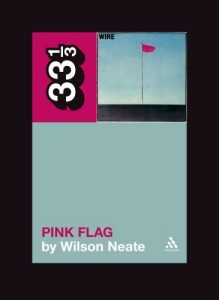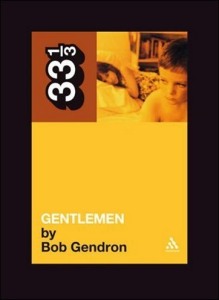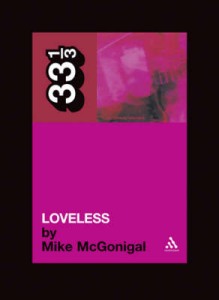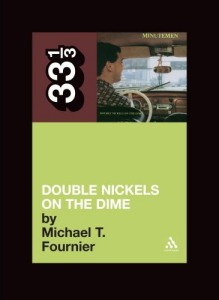
I first noticed that Continuum had chosen an author for a 33 1/3 book on a Wire album when I was checking out who else on Last.FM was obsessively listening to early Colin Newman solo records. Lo and behold, one of my fellow devotees had been slotted to write the book about Pink Flag. This moment occurred shortly after I’d narrowed down the records that I could conceivably write 33 1/3 books about—barring all of my preferred options that would never be accepted (Juno, Shiner, Hum, Castor, Jawbox, Silkworm, Shudder to Think)—to Wire and Slint albums, with the possible addition of Girls Against Boys’ Venus Luxure #1 Baby, so reading his announcement was bittersweet, just like it’ll be when someone is chosen to write about Spiderland.
I can understand why Continuum chose Pink Flag, since it probably has the largest cross-over appeal of the three early Wire records, even though I would have opted for either the post-punk perfection of Chairs Missing or the unrelenting progress of 154. Whereas those two albums are firmly in the post-punk camp, Pink Flag occupies a liminal space between punk and post-punk, a concept that Wilson Neate investigates during the first half of the book. While no one explicitly stated this viewpoint in the book, I’m sure there are punk-rockers out there who love Pink Flag but have no time for either Chairs Missing or the willfully difficult 154. Those punk rockers and their post-punk peers will be well served by Neate’s book.
Neate’s Pink Flag is divided in two rough halves: the first five chapters are devoted to biographical, historical, and contextual coverage and the massive sixth chapter provides commentary on each song. Considering that Kevin Eden’s Everybody Loves a History speeds through much of this period in order to give equal space to the group’s post-Wire output and post-reformation material, Neate’s thorough exploration of Wire’s early years is quite welcome. Eden’s book glosses over George Gill’s tenure in the group, but Neate emphasizes how Gill’s clichéd rock ‘n’ roll approach gave the other four members something to model their minimalist approach against. The Clash provided a similar model, which led to some cold interactions between the groups. Wire? Cold? Never!
Doing the song-by-song approach works for some 33 1/3 books (Double Nickels on the Dime in particular) and it could have easily been the bulk of this book, given that Pink Flag has 21 tracks and the chapter spans 60 pages. Neate notes how several correspondents had difficulty extracting favorites from this string of songs, viewing it more as one complete document, which I can understand to some extent. Certain songs—“Reuters,” “Ex-Lion Tamer,” “Pink Flag,” “Mannequin,” “12XU”—stick out to me, but there’s a string of others, especially on side B, that flow together. Reading about them as separate songs shortly after I’d listened to the record was quite interesting, but I still had a hard time remembering a few of the songs’ melodies.
The post-script is relatively limited, jumping from just after Pink Flag to Elastica’s appropriation of “Three Girl Rhumba,” to that song’s use in a British H&M ad, and finally to Bruce Gilbert’s self-removal in 2004. It’s a transition focused on the financial side of the band, in which Colin Newman redid the writing credits for Pink Flag to give himself more royalties (he’d written the majority of the guitar parts, but Bruce Gilbert played most of them on the recording). Neate makes the point that the rock side won out over the art side, which is quite clear to anyone who’s read Object 47, Wire’s first post-Gilbert LP. Bits of Wire’s post-Pink Flag history are sprinkled throughout the book, but don’t expect any emphasis on “Outdoor Miner” or “The 15th.”
My biggest critiques are editorial in nature. At 150 pages, Pink Flag is on the long side of 33 1/3 books, surpassed in my stack by only the tomes on Bee Thousand and Exile on Main Street. The length would be fine if not for thematic repetition in the first half of the book, in which various points (Wire’s minimalism in particular) are reinforced several times over by multiple quotations. Graham Coxon provides an undue amount of these quotations, which baffles me in the presence of Albini, MacKaye, Prescott, Rollins, Watt, etc. Ultimately, Pink Flag the book would have benefitted from some of Pink Flag the album’s signature economy.
Despite these minor caveats, Neate does an excellent job bringing a Wire album to the 33 1/3 canon, finding a similar level of success to Bob Gendron’s Gentlemen. I doubt that most fans have tracked down Everybody Loves a History, but Pink Flag is a more succinct, more focused option for those who do not care to read about the genesis of The Ideal Copy. I’m holding out hope that Wire is granted one or two more entries in the 33 1/3 series, since Chairs Missing and 154 deserve equal treatment, but barring a major shift in Continuum’s approach, that’s not going to happen, so go pick up Pink Flag.
|

In the growing stack of 33 1/3 books sitting on my desk hutch, five of the albums covered made my Record Per Year list (the Rolling Stones’ Exile on Main Street and David Bowie’s Low might’ve joined this list if I had been born a decade earlier). Yet the Afghan Whigs’ Gentlemen sticks out as the album I was most excited to read a book about, owing to a combination of the Whigs’ comparatively relative fame (or perhaps, more appropriately, infamy), the deep-rooted emotional attachment I have for the record, and the strange circumstances involving my acquisition of a copy. I was a freshman in high school when I heard “Debonair” and “Gentlemen” on WDST, Radio Woodstock, but it took one of my friends mistakenly getting a copy of Gentlemen from BMG Music Club and then trading it to me for five bucks and an extra Obi-Wan Kenobi action figure for the album to make it into my hands. Trading a youthful artifact for Greg Dulli’s seedy, adult world and unrelenting self-flagellation seems like the devil’s own recipe for adolescent disaster, but even without a trace of the album’s sex and drugs, I was able to transfix my high school alienation to Gentlemen’s post-graduate despair.
I knew that Bob Gendron—a writer for the Chicago Tribune and editor of The Absolute Sound and Playback—was tabbed to write a 33 1/3 volume on Gentlemen, but its appearance in the Harvard Book Store took me by surprise. Unlike the lengthy delay for Mike McGonigal’s Loveless (which hardly lived up to the wait), Gentlemen snuck up on me and did not disappoint. Like the other volumes in the series that I’d recommend without hesitation—Michael T. Fournier’s Double Nickels on the Dime and Hugo Wilcken’s Low—I tore through the 114 page volume in a single sitting and immediately pulled out the album for a dedicated listen.
Gentlemen falls in line with more traditional 33 1/3 entries, covering the band’s back story, the album’s creation, the critical response, and the enduring legacy in lieu of a central conceit like Joe Pernice’s coming-of-age novella Meat Is Murder or Kate Schatz’s presumably catharsis-driven Rid of Me: A Story, but Dulli’s relationship trauma and coke binges hardly require fictional ballast. Solid coverage is given to the group’s early days on Sub Pop, but Gentlemen wouldn’t exist without the conscious decision to separate themselves from their flannel-clad peers and the lingering stain of the “soul grunge” label. Yet the core of the book comes with the investigation of Dulli’s relationship with Kris, which prompted the album’s conceptual focus, and the subsequent substance abuse. One night during the recording session in Memphis, a local stripper that Dulli brought back to the studio witnessed the coke-addled singer rip through final takes of five of the album’s songs. While the titillation of Dulli’s infidelities and drug usage reminds me of how entertaining the Replacements and Butthole Surfers chapters of Michael Azerrard’s Our Band Could Be Your Life were in comparison to chapters on preferred acts like Dinosaur Jr. and Mission of Burma, Gendron’s discussion of the group’s soul influences and fallout with Elektra Records is just as memorable. I had no idea that Terry Tolkin, the A&R man at Elektra, was partially behind the infamous Fat Greg Dulli fanzine, but this post at A Deeper Shade of Soul helps elucidate that particular topic with further comments from Dulli’s close friend, actor Donal Logue. (I remember the two of them hosting 120 Minutes and reenacting scenes from their favorite movies—I could only wonder if dudes got much cooler than them.)
My quibbles are minor. The opening of the book suffers from an awkward transition from Dulli’s near-death experience following an attack in an Austin night club in 1998 to a description of Dulli’s gallivanting playboy ways, but I prefer the former event being covered at the start of the book as opposed to the end. Gendron’s occasional dismissals of recent music trends might date the book, like a mention of the Juno soundtrack as an example of the lingering prudishness of indie/alternative rock, but I can’t harbor resentment about Gendron’s longing for the days of LP artwork in favor of iTunes thumbnails given my overwhelming preference for vinyl. The dismissal of Black Love in two short paragraphs as a bloated album choosing instrumental glut over clear melodies underscores Gendron’s clear preference for its predecessor, but I have little doubt that Black Love is the second-best Whigs album. My biggest complaint is actually a compliment in disguise: I simply wanted more.
Reading that Gentlemen sold only 160,000 copies and never cracked the Billboard Top 200 made me feel lucky to own a book on such a personal favorite. He also mentioned that few publications put the album in their top 10 lists for 1993 and Pitchfork’s Top 100 of the 1990s lacks even a mention of the group, but those critical blind spots made me proud to mention that Gentlemen was #33 in the Signal Drench 100 of the 1990s. (It would rank even higher in my personal list.) The Afghan Whigs have been a love-’em-or-hate-’em proposition, but those in the former camp would be wise to track down Gendron’s Gentlemen.
|
|
Although I’d previously only read one of the 33 1/3 books from cover to cover—Ben Sisario’s solid, if unspectacular tome on the Pixies’ Doolittle—I’ve had my eyes on a few of them over the last few months, eagerly waiting for the available time to read something other than critical theory. I skimmed through a handful of the books today at the Harvard Book Store, opting for entries on Loveless and Double Nickels on the Dime (which was written by my ’90s-indie-rock-lovin’ doppelganger, Michael T. Fournier). Despite running into Mike at the Newbury Comics in Harvard Square shortly after purchasing his book (“It’s funny I ran into you… guess what I just bought?”), I somewhat arbitrarily opted to read his book second, perhaps because I’d been waiting to read the other book for some time. Just like I’ve been waiting for a My Bloody Valentine record for some time. Imagine that.

Though the numerous delays that marked the slow-crawl publication of Mike McGonigal’s entry on My Bloody Valentine’s Loveless are amazingly appropriate given the book’s subject, I worried about whether the book would justify the delays. Well…
McGonigal simply tries to do too much. I would have been happy with a detailed account of the recording sessions, but McGonigal skips between his memories of the band’s live show, the interpersonal discord, the label issues, the aesthetic touchstones (in a goddamn top ten list in the middle of the book), “where are they now,” the notable followers, a stripper dancing to “Sometimes,” his connections to the I Love Music board (really), and his short reviews of the songs. There’s a chapter essentially on Rafael Toral’s Wave Field. Loveless (the album) has such a massive mythology surrounding it that 117 pages isn’t enough to go in-depth about all of these topics, even if the inclination is that all of them (well, most of them) need to be discussed. Are there interesting facts in almost all of these categories? Sure. Would the book have been a more compelling read if he had cut a few of them out? Yeah.
Perhaps the cause of the book’s topical happy feet is Kevin Shields, who consented to interviews for the project but frequently comes off of as a frustrating interview subject. While he does his fair share of debunking myths and giving insights into this particular recording process, many of his answers deny one thing without filling in the actual information. When asked about lyrics, for example, Shields laughs about how massively incorrect the various online transcriptions are and then avoids giving any examples of the actual lines. There’s a myth to debunk and a myth to maintain, after all. The other members of the band give far less, if any input (Colm O’Ciosoig did not contribute). Yes, Loveless is Shields’ album, but hearing about his thought process from the others involved, especially Bilinda, is frequently insightful.
Rather than close the book with the dishearteningly vague possibility of a reunion/follow-up record (which he even notes wasn’t his original ending), series editor David Barker told McGonigal that a more upbeat ending would help the text. Oh. After that point, McGonigal gets self-referential about the project, recognizing that “I know this is a short book…” before stumbling onto Loveless’s critical legacy and then a final chapter on that Toral album. What is this, A.I.? I understand Barker’s impetus for a different ending, but having three separate, disjointed endings and discussing each as such is rather infuriating.
Despite the overly broad scope of the book, Shields’ gentle posturing, and the stuttering conclusion, Loveless (the book) still has moments that spur my genuine interest. Hearing briefly about O’Ciosoig’s illness, depression, and eviction during the recording process made me understand why he’s essentially a digitized ghost on the album. Reading about how Deb Googe had almost no part in the recording process clarified her later fronting role in Snowpony. Finding out about Bilinda’s dissolving relationship with Shields and her son from a previous relationship gave shape to her frequently amorphous voice. McGonigal had a fairly thankless role in writing about such a mystified album, but I wish more of the book had focused on the points of interest rather than baffling semi-tangents.

In contrast to an underwhelming entry on an album I love, Michael T. Fournier’s entry on the Minutemen’s Double Nickels on the Dime did exactly what I hoped it would: stoke my interest in an album I’m not nearly as familiar with. Between the conversational insights on the songs from years of listening, the discussions with Mike Watt, and the close readings of the songs’ topical and musical motifs, Fournier makes the forty-five-song behemoth seems entirely approachable.
Although the book’s organization (chapters on each side of the album, specific discussions of the songs in order) seems considerably more straightforward than the books on Doolittle and Loveless, this structure allows Fournier to establish the thematic ties of each side and of the record as a whole while keeping the focus on the individual songs. While Fournier encourages skipping around to read about your favorite tracks on the album, reading about them in the context of each band member’s side helps makes sense of how D., Mike, and Georgie each operated. Thinking about the record in terms of the “fantasy draft” (each band member picked the songs for their side and left the rest for the “Side Chaff” ) is endlessly entertaining for me, given my fondness for fantasy hockey, but it also establishes who prefers which songs and why.
This structure is held together by a deluge of information from a variety of perspectives. Thinking about who wrote which songs (many were contracted out to the band’s friends to keep things fresh), which bands influenced particular songs (whether funk or Wire), and the political commentary of specific tracks keeps the book moving along, but deeper insights like Mike Watt’s admission of the influence of Joyce’s Ulysses on a number of his songs made me sit up and take notice.
Fournier doesn’t dwell much on the band’s fate, avoiding McGonigal’s urge to append ending after ending. While I wouldn’t have minded a post-Double Nickels on the Dime summary after the final chapter, the book seems complete without it since Fournier contextualizes the album within the band’s larger catalog. The best course of action would be to watch the Minutemen documentary, We Jam Econo, to fill in the biographical gaps and to feel the sweat of the band’s live performances and then read the book to truly embrace the individual songs.
Michael T. Fournier’s Double Nickels on the Dime accomplishes the two feats all of these books should aim for: bolster my knowledge about an album and make me want to hear it again. After finishing the book, I wanted to skip through the record and listen to “West Germany,” “June 16th, “No Exchange,” “The Politics of Time,” “History Lesson Part II” and countless others while re-reading sections of the book. Oh, but I also wanted to listen to each side as such and then listen to the album as a whole. I can’t say that I felt the impulse to hear more than a few songs of Loveless again after finishing that book and certainly didn’t twitch to re-read the book itself.
I imagine that I’ll read a few more of the 33 1/3 books over the next few months (the entries on David Bowie’s Low, the Rolling Stones’ Exile on Main St., and Guided by Voices’ Bee Thousand are all intriguing), but for now I’ll have to do with listening to Double Nickels on the Dime as I flip through the particular notes.
|
|
Five more books, zero from the list.
Banville, John. Ghosts. 245 pp.
Heaney, Seamus. The Burial at Thebes. 79 pp.
Nabokov, Vladimir. Invitation to a Beheading. 223 pp.
Nabokov, Vladimir. Transparent Things. 104 pp.
Sisario, Ben. Doolittle. 121 pp.
I picked up a handful of Banville’s novels on the cheap from Half.com when I ordered No Laughing Matter: The Life and Times of Flann O’Brien, but Ghosts is the first of them that I’ve tackled. Banville’s weighty, wordy prose style and the slow-moving drifts of the subject matter are a bit of an odd combination, particularly without the narrative propulsion of Nabokov, but ruminating over the novel after the fact been rewarding, even if the actual reading experience seemed . Given that I just found out that this is the second book in a trilogy (along with The Book of Evidence and Athena, neither of which I own), some of my problems with the novel—foremost how the shadows of character development were both intriguing and somewhat infuriating—are thrown out of the window.
It’s tough to get away from Nabokov, in part because I keep picking up his novels from the library, the book store, or the library book sale, but this pair kept my momentum going. Transparent Things is a successful novella, relatively compelling in its brief length without seeming incomplete. Invitation to a Beheading covers some of the same thematic ground as Bend Sinister, but resides almost exclusively in the prison setting. It isn’t as griping or quite as allusive as that novel, and if you’re going to read one, Bend Sinister is the obvious pick, but Invitation is an excellent alternate pathway to travel. I’m stunned that I didn’t glance at the back cover before finishing the novel—I purchased the book after having read a brief description online—but completely thankful for this, as it gives away every major plot point in the novel. If not for Nabokov’s somewhat neurotic musings (this time it’s about how the novel is always thought of as being inspired by Kafka, yet Nabokov hadn’t read any Kafka prior to writing it), I’d be able to give up reading introductions, forewords, prefaces, et al, altogether.
Burial at Thebes takes an entirely different poetic approach than Heaney’s more famous translation/reimagining of Beowulf, cutting down on the kennings and emphasizing the readability and direct impact of the text for today’s political climate. In terms of his intentions, it’s successful, but the majority of translations lack the risk/reward factor of Heaney-wulf, especially this one given the contrast. Perhaps I’d have a different verdict if I had seen this performed, but if I’m itching to read some Heaney, it’s still going to be his poetry (North in particular) or his version of Beowulf.
Doolittle is the first entry from the 33 1/3 series that I’ve picked up (Loveless will likely be the next). Unlike some of the other books in the series—Joe Pernice’s semi-fictional prose for Meat Is Murder, for example—this is a fairly straightforward contextualization and explanation of the album’s time period, impact, and themes (primarily Surrealism). Sisario drove around with Frank Black, gathering notes and anecdotes, but perhaps the biggest remnant of this experience is a lingering reticence on the part of Black Francis to discuss the album in detail. The other members of the band have far less input—Kim Deal, as per usual, has none at all—but it’s still a worthwhile read. I really like the idea and aesthetic execution of the series, so hopefully the trend of covering albums I genuinely enjoy will continue.
Jon keeps telling me that I need to write a book for this series on Juno’s A Future Lived in Past Tense, but despite our mutual fondness for this record, I’m not sure if Continuum would be able to justify the expenditure. Juno fans seem to be remarkably rabid individuals, but they have not yet funded a grant for this project. The bittersweet thing about this line of jokes is that I would be both thrilled and somewhat prepared to write this book. If anyone wants to fund a 44 1/4 series covering the finest records from Juno, Shiner, Hum, Jawbox, Shudder to Think, and Castor, please do it.
|
|

